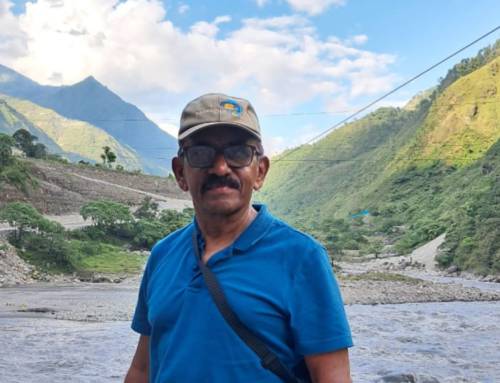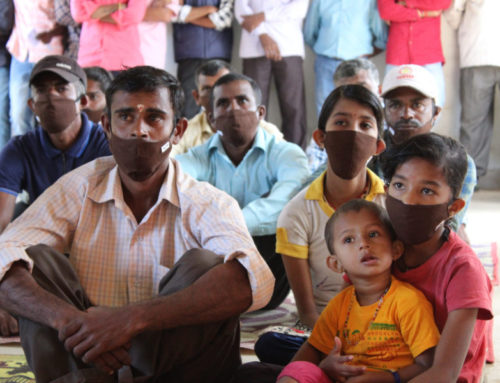Authors: Priyadarshini D. and Dr. Krithi K. Karanth
“Whether the crop is destroyed or earns a profit, the laborers have to be paid their wages,” says Nagaraju. A few feet away, five women briskly plant onion bulbs in the freshly dug soil of his three acre plot. It is April and the mercury has already hit the high 30s by mid morning. Nagaraju and the women soon break for lunch, having toiled in the sun since dawn. The landscape around is largely arid. Nagaraju’s land hugs\a sparsely wooded hillock. Less than a kilometer away is Bandipur, a premiere national park and tiger reserve in the state of Karnataka, India.
For people living so close to Bandipur brings daily adventures and challenges. Once, unable to afford a torch, Nagaraju nearly ran into an elephant near his field. More often, he finds them grazing in his field. His potato crop was recently damaged by elephants. “I can hardly eat when I wake up to that,” he says. His anger is palpable. He estimates a cost of around $716 to cultivate an acre. This includes labor wages, which he pays irrespective of his losses. Economic costs, apart from human injury or death, are visible consequences of such human wildlife interactions. For families like Nagaraju’s, who can barely make ends meet from their land, such repeated conflict and cost impose a tremendous emotional and economic drain.

A double decker bus stop – The upper storey was built to protect people from elephants that would often settle down in the forest patch right behind the bus stop.
Experiencing conflict has other, often hidden dimensions, like quality of life and food security. Nagaraju works as a migrant laborer in Kerala to supplement his income. It becomes difficult to leave my children behind, he grieves. They are aged just four and one. For many families, loss of crops or livestock also means loss of food on their tables. Often, fear keeps them at home after
dark, with little scope for communal bonding. At times, as with Nagaraju who wants a better future for his children, it takes the form of pent up frustration from unrealized aspirations. This has also been supported by a study conducted on the hidden costs of human wildlife conflict (Barua et al. 2013).
India reported a total of 78,656 human wildlife conflict incidents from 18 states in 2012-2013 – period for which complete data is available – of which nearly 73.4% were crop loss and property damage. A total of $5.3 million was paid out as compensation during this time. Of this, Karnataka reported both the highest number of incidents at 36,091 incidents with 34,576 incidents or nearly 95.8% of these being for crop loss and property damage, and paid out the highest compensation totaling $1,956,115 (Karanth, Gupta, and Vanamamalai, 2018; in press, Biological Conservation).

A machan overlooks fallow fields bordering thick forest. Being vigilant is both a necessity and an opportunity cost for farmers living in such close quarters with wildlife.
To alleviate the loss, the government in Karnataka is one among 22 states in India that offers compensation for crop damage and among 18 states for property loss for affected families. This allows them to recoup some losses, though not all, resulting from damage to their crops or property. The success of this measure however suffered from implementational issues.
Nagaraju and Satheesh and their families are now hopeful. With assistance from Wild Seve – a project jointly implemented by the Centre for Wildlife Studies, India (www.cwsindia.org) and the Wildlife Conservation Society, New York (https://www.wcs.org/) – Nagaraju has filed four claims for compensation for crop loss, receiving around $50 so far. Likewise, Satheesh has filed 15 claims for crop loss and property damage, receiving around $430 till date. But it is more than compensation alone. Wild Seve provides the necessary logistics by responding immediately to calls, documenting and filing claims, and also following up diligently until claims are processed by the department and compensation is received by the claimant. Thus, claimants are saved time and transactional costs which had discouraged many in the past. For marginal farmers like Nagaraju, this is particularly helpful as pursuing compensation is an opportunity cost he can ill afford.
Chandrashekar is relieved too. His village Tholalu lies in the tri-junction of Hediyala, Nuggu and Omkar forest ranges of Bandipur. Bounced from one range office to another due to jurisdictional confusion, he was fed up. Wild Seve has helped him and others overcome this confusion and file their claims with the appropriate range office.

Project Coordinator of Wild Seve (extreme right) assists affected families every step of the way. This frees up time, money and energy that people might otherwise spend chasing claims. He is seen here, training the field staff.
Wild Seve also reduces transaction costs like travel expenses and obtaining supporting documents such as photographs and crop certificates. Besides, the helpline is toll free.
Veluswamy from Bankahally in the Hediyala range points to another, maybe unintended, outcome of Wild Seve: transparency. He claims to receive more compensation now than he did previously. Satheesh too refers to the meticulous verification of ownership and incidents carried out by Wild Seve before filing claims. Both are alluding to a practice earlier of diversion or capture of compensation amounts by false claimants, emboldened by lax verification by the department. With Wild Seve, compensation has been reaching the right beneficiary. Most of all though, it is the response time that has struck a chord. Wild Seve field staff respond within 24 hours of a call and every claim is submitted within a week of the incident. All this, in turn, has cut the time taken for compensation in half.
The true measure of Wild Seve’s success may be the appreciation and relief evident on Nagaraju and Satheesh. For here is a phone number that not only goes through, but also promises prompt assistance.
Scientific References:
Barua, M., Bhagwat, S. A., Jadhav, S., 2013. The hidden dimensions of human–wildlife conflict: Health impacts, opportunity and transaction costs. Biological Conservation. 157: 309-316
Karanth, K. K., Gupta, S., Vanamamalai, A., 2018. Compensation payments, procedures and policies towards human-wildlife conflict management: Insights from India. Biological Conservation (doi:10.1016/j.biocon.2018.07.006)




